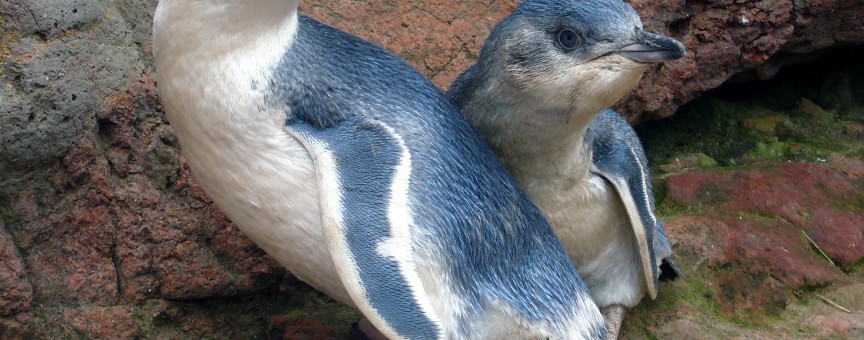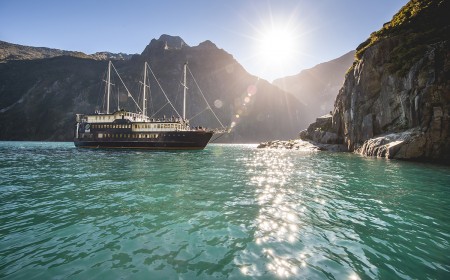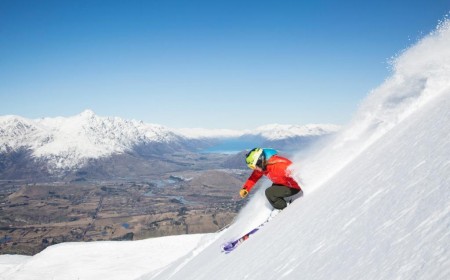Banks Peninsula penguins thriving, thanks to local farmers and tourism
A downturn in farming, and absolute determination from a group of Banks Peninsula farmers to stay afloat, was the inspiration for one of New Zealand’s most beautiful and diverse walking tracks – the Banks Track. The thousands of tourists who have paid to walk the track have also helped prevent the extinction of Canterbury’s White-flippered Penguin and the last Sooty Shearwater Colony on Banks Peninsula.
Formerly known as the Banks Peninsula Track, the three-day trek along Banks Peninsula’s remote south-eastern coastline, has in the last two years taken on a new shape with the removal of one farm and addition of a spectacular red beech forest. “We have also retained all the features that walkers have loved - the penguins at Flea Bay; the ‘bath under the stars’ at Stony Bay; the coastal scenery; and being amongst the animals and activity of working farms, ” farmer and conservationist Shireen Helps says.
Shireen, and her husband Francis, own the third farm that trekkers visit on their circuit from Akaroa, over the hill to Flea Bay, along the coastline, and back through Hinewai Reserve to Akaroa. They have been working the 550 hectare Flea Bay property for more than 40 years and, were not only instrumental in helping to establish the Banks Track during the mid 70s farming crisis, but have brought hundreds of local and overseas tourists to this remote part of Canterbury to observe their ongoing efforts in preserving its native bush and indigenous wildlife.
Ever since a 21-year-old Francis and his 19-year-old brother Steven began tending the land in the late 1960s, the family has been dedicated to conserving its natural heritage. At the same time as removing gorse and planting grass for their sheep, the young men were protecting the areas covered in native bush under various reserves and covenants. Among these was the Tutakakahikura Scenic Reserve, an untouched stretch of native forest, which was gifted to the Department of Conservation in the 1980s.
It is this type of untouched wilderness that tourists such as Canadians Rene Dinh and Marie-Helene Le Vesque say they have travelled to see. “It’s what set New Zealand apart when we were deciding between here and Australia. And it’s what we’ll be telling our friends about when we go home,” Marie-Helene says.
Rene and Marie-Helene also travelled to Flea Bay to kayak and see the area’s now legendary penguins. From their kayaks, they managed to capture stunning photographs of the birds and other local wildlife on the Bay’s rocky outcrops and steep cliff faces. “It’s the very best momento for an eco-tourist to take home with them,” Rene says.
Tourist visits to Flea Bay are always carefully planned by the Helps company, Pohatu Penguins, and only small groups are permitted, limiting their impact on the penguins, and reinforcing messages about this still fragile ecosystem. Ironically, many Flea Bay visitors will be unaware that at all times they are usually only a few metres from a penguin. “People regularly say ‘where are these penguins? I haven’t seen any,’ and I’ll see one under a rock or piece of wood, right beside them,” Shireen says.
The penguins were quick to make their mark on the environmentally aware Helps when they first arrived at Flea Bay. On his very first night at the property, Francis was kept awake by raucous penguins in the pre-breeding season. “We are both from long-established Banks Peninsula farming families, so knew about the penguins here, but became increasingly disturbed by the number of dead birds we were finding,” Shireen says.
Banks Peninsula used to be home to thousands of White-flippered penguins but, in the 30 years prior to the Helps arriving at Flea Bay, more than 80 per cent of the population had been wiped out by the introduction of land-based predators such as stoats, ferrets, feral cats, possums, rats and even hedgehogs. “We could see what needed to be done but the general view was that the penguins in Banks Peninsula were too close to extinction to spend a lot of time and money protecting them,” Shireen says.
“We didn’t have much money but whenever we had some spare cash we’d buy a couple of traps to help keep the stoats and ferrets away. We also created nesting sites, monitored the penguins and rehabilitated any that were struggling to survive.”
In 2000, the Helps and others concerned about the penguins’ survival, convinced the Department of Conservation (DOC) to do a survey of the number of penguins on Banks Peninsula. The research told a sad story, of only a few remnant colonies in sea caves and under cliffs, until it reached Flea Bay and nearby Stony Bay.
Thanks to the work of the Helps, who had 717 breeding pairs, and their neighbour Mark Armstrong, who had 45 breeding pairs, saving the White- flippered penguin colonies on Banks Peninsula no longer seemed a lost cause. “DOC then put a trapline right around us and it got rid of the last of the ferrets,” Shireen says. Mark was also successful in bringing the last Sooty Shearwater colony on Banks Peninsula back from the brink of extinction to more than 50 breeding pairs.
Today there are 1260 breeding pairs of White-flippered Penguins in Flea Bay – the largest number of Little Penguins on mainland New Zealand. It is a few less than the peak number of 1304 pairs in 2012 but the slight decline in population has been due to natural causes, including a couple of poor breeding seasons and ocean predators such as Giant Petrels.
Without the tourism money coming the Banks Track and now Pohatu Penguins, Shireen and Francis say they and their family, including son Daniel, and daughters Josephine and Jessica, would not have been able to devote as much time and money to conservation. “Before the track, we had to scrape every dollar out of farming. It gave us the excuse we wanted to properly look after this precious place. While we still run a successful working farm, fifty per cent of it is now in native bush for us and future generations to enjoy,” Shireen says.
Pohatu Penguins has won many conservation awards including the ‘Canterbury Aoraki Conservation Board Award’ in 2010; the ‘Balance Heritage Restoration Award’ in 2008; a ‘Community Service Award for Conservation’ in 2001; and DOC’s ‘2018 Conservation Week Award’.





